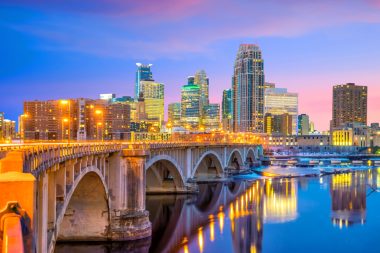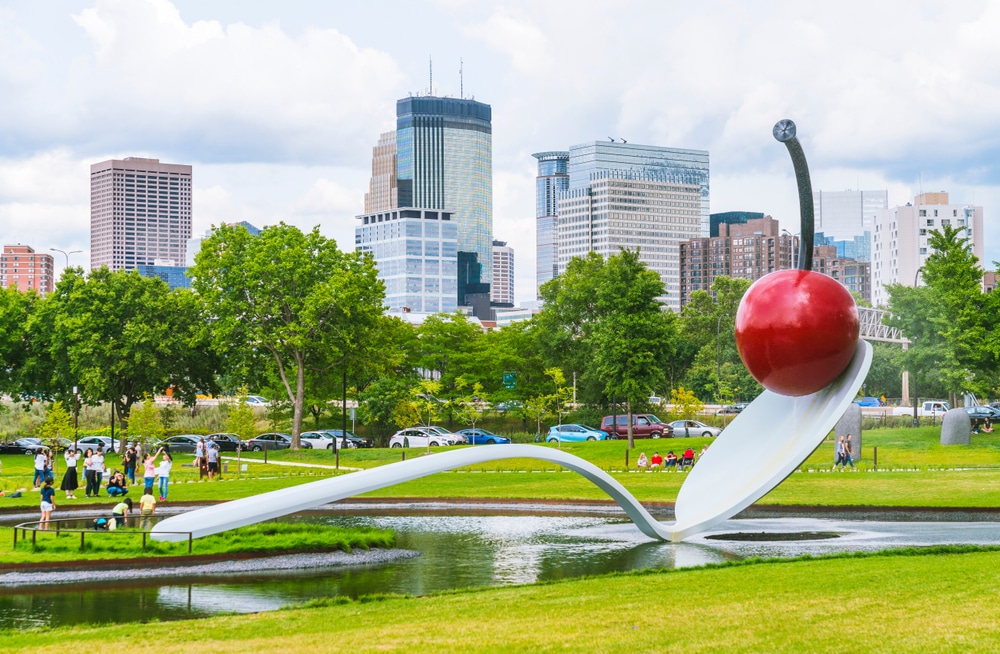Located in the state of Minnesota in the upper Midwest of the USA, Minneapolis is the largest city, but not the federal capital. Right next door is St. Paul, the actual capital of Minnesota with the seat of government of the state. Together, the two cities form the so-called “Twin Cities”, a metropolitan region with more than 3.5 million inhabitants. Minneapolis itself has 430,000 inhabitants. The name is based on the Greek “polis”, which means city, and the Indian “minne” for water. This is no coincidence, because the Mississippi winds through Minneapolis. In addition, the city is dotted with smaller and larger lakes. This earned it the nickname “City of Lakes”. In addition, parks run like green oases through all parts of the city and invite you to rest or have a picnic.
Impressive art and theatre scene
Even though there are many cities in the USA with a greater reputation, Minnesota’s largest city does not need to hide behind them. One of the city’s greatest sons also appreciated this: singer Prince was at home here. Minneapolis has a very vibrant arts and theater scene, as well as a shopping center that has the most visitors in the world. The “Mall of America” is, in keeping with its name, the largest mall in America. But the superlatives are not exhausted, because in addition to 50 restaurants and 520 shops, there is also the largest covered US amusement park. If you want to plunge into shopping more often, you can even stay in the integrated hotel of the mall called “MOA”.
When it comes to art museums, Minneapolis can boast several highlights. The Walker Art Center was founded in 1879 and moved into its current location in 1927. Newsweek magazine calls the contemporary art museum one of the best in the country. “Free admission” is the motto in the sculpture park of the “Walker Art Center”. More than 40 sculptures surprise visitors here, such as “Spoonbridge and Cherry”. The oversized spoon with the same cherry stands in a water basin with a fountain and is very popular for a souvenir photo. The Walker Art Center and the Sculpture Park extend over 69,000 m². Not far from the sculpture park is the magnificent church “Basilica of Santa Maria”. The white church with its dominant domed tower is also worth a visit inside.
Impressive museums in Minneapolis
Another important art museum in Minneapolis is the Institute of Art. More than 80,000 different exhibits outline the world history of the last 5,000 years on the museum’s 32,000 m². The photographs, pictures, prints and other objects bring together collections from four continents. A highlight of the exhibition is ceramics and architecture from China.
The Bell Museum is Minnesota’s official natural history museum. Located in Minneapolis’ twin city of St. Paul, it also houses a planetarium in addition to its impressive and interactive exhibit. A wide variety of programs are offered here.
All in all, a considerable part of Minneapolis has become a large gallery – free and outside. The city is covered with murals. On First Avenue is an icon of murals in the shape of stars for the often local stars of the music scene. Of course, Prince can also be found here! Bob Dylan has his own mural on 5th Street, which impresses with its colorful presentation and Bob Dylan’s oversized face. Murals such as “Bulldog” with countless details or “Vintage Car” in the form of a 50s comic are far more artistically designed. If you keep your eyes open in this city, you will find what you are looking for in countless places, on large and small streets as well as in backyards.
The best way to explore the city is by car, bike or on foot via the “Grand Rounds National Scenic Byway”.
Getting around by bike and on foot

The network of interconnected avenues leads over 50 miles of squares and places that tourists cannot miss. This is not only about important buildings, parks or canals, but also about rivers, lakes and whale areas. Cycling and hiking trails are an integral part of the “Grand Rounds”. It includes seven areas:
• Downtown Riverfront
• Chain of Lakes
• Minnehaha Falls Regional Park
• Mississippi River
• Northeast of the city
• Victory Memorial Monument
• Theodor Wirth Park, named after the long-time superintendent of the city parks, who is responsible for the current park system in Minneapolis
Between 1880 and the 30s of the 20th century, Minneapolis was considered the world’s flour mill capital. In the historic district of Saint Anthony Falls, the Mill City Museum is located in an old mill complex. It has the status of a “National Historic Landmark”. There were once countless mills in this district, of which only a few buildings remain today. In total, the district has a good 60 historical objects that are worth visiting.
Fittingly, there is an almost 3 km long hiking trail in the Saint Anthony Falls District, where signs explain the past of the district to the visitor. Of course, the path also leads past the “Saint Anthony Falls”, the only large natural waterfall on the Mississippi. St. Anthony was once a separate city on the east side of the falls, while Minneapolis stretched out on the west side. In 1872, the towns were merged. Today, the waterfalls consist of locks, their upper dam and an overflow. They are not far from the bridge on 3rd Avenue, which is also called the “St. Anthony Falls Bridge”. The 668-meter-long bridge, like the falls, is a landmark of Minneapolis. State Route 65 leads over its 7 curves over the course of the river.


